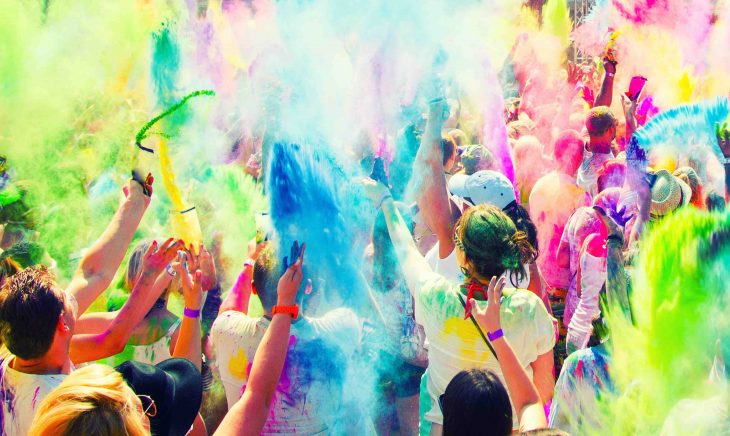
Holi is a joyous and exuberant festival celebrated by millions of people in India and across the globe. Also known as the “Festival of Colors,” Holi brings people together to embrace the arrival of spring and bid farewell to winter. In this article, we delve into 11 fascinating facts about Holi that will take you on a vibrant journey into this captivating festival.
Ancient Origins
Holi has ancient roots, dating back to Hindu mythology. It is believed to have originated from the legend of Lord Krishna, a mischievous deity who enjoyed playing pranks and drenching people in colored water.
Arrival of Spring
Holi is celebrated on the day after the full moon in the Hindu month of Phalgun. This marks the arrival of spring, a season of new beginnings and renewal. The festival usually falls in March, symbolizing the victory of good over evil and the blossoming of nature.
The Bonfire Ritual
On the eve of Holi, people gather around bonfires in a ritual called Holika Dahan. This represents the triumph of good over evil and commemorates the burning of the demoness Holika. The bonfire symbolizes the destruction of negative energies and the purification of the soul.
Colors Galore
The most iconic aspect of Holi is the playful and vibrant colors that fill the air. People throw colored powders and water at each other, creating a kaleidoscope of hues. These colors hold significant meaning; red symbolizes love and fertility, blue represents the divine, green symbolizes new beginnings, and yellow signifies piousness and knowledge.
Playful Water Fights
Water balloons, water guns, and buckets of colored water are all part of the playful water fights during Holi. Young and old alike indulge in drenching each other, breaking barriers and spreading joy. It’s a delightful way to embrace the festival’s spirit of camaraderie and letting go of inhibitions.
Bhang Delicacies
Bhang, a traditional Indian drink made from cannabis, is a popular delicacy consumed during Holi. It is prepared by grinding cannabis leaves into a paste and mixing it with milk, spices, and nuts. Bhang is known for its intoxicating effects, and its consumption during Holi adds to the festive merriment.
Traditional Sweets
No Indian festival is complete without indulging in traditional sweets, and Holi is no exception. Gujiya, a sweet dumpling filled with khoya (milk solids) and nuts, is the quintessential Holi delicacy. Other popular sweets include malpua (fried pancakes), jalebi (syrup-soaked spirals), and thandai (a refreshing milk-based drink).
Festive Music and Dance
Music and dance form an integral part of Holi celebrations. People gather to sing traditional folk songs and dance to the beats of drums and other musical instruments. The infectious rhythms and lively melodies create an atmosphere of pure joy and enthusiasm.
Regional Variations
Holi is celebrated with great enthusiasm across different regions of India, and each region adds its own unique flavor to the festivities. In Mathura and Vrindavan, the birthplace of Lord Krishna, Holi is celebrated with grandeur and traditional plays reenacting episodes from Krishna’s life. In Punjab, the festival coincides with the harvest festival of Baisakhi, leading to even more vibrant celebrations.
Unity and Brotherhood

Holi transcends social barriers and promotes unity and brotherhood. During this festival, people come together, forgetting their differences and embracing the spirit of love and togetherness. It is a time to mend broken relationships, forgive, and start anew.
Global Celebrations
Holi’s popularity has spread far beyond India, and it is now celebrated in various parts of the world. Major cities across the globe host Holi festivals, attracting people from diverse backgrounds. These events showcase the multicultural spirit and bring people together in a colorful celebration of diversity.
Final Word
Holi is a festival that embodies joy, love, and the vibrant spirit of life. With its ancient origins, colorful traditions, and universal appeal, Holi continues to captivate hearts and minds around the world. Together with its vivid colors, playful atmosphere, and rich traditions, Holi remains one of the most beloved festivals in India and beyond. Embracing the spirit of unity, love, and renewal, Holi brings people together in a joyful celebration of life and the vibrant hues that surround us.
(Frequently Asked Questions (FAQs)
What is the history behind Holi?
Holi has its roots in Hindu mythology and is associated with Lord Krishna. It celebrates the triumph of good over evil and the arrival of spring.
Why is Holi known as the Festival of Colors?
Holi is called the Festival of Colors because people playfully drench each other in colored water and throw colored powders during the celebrations.
When is Holi celebrated?
Holi is celebrated on the day after the full moon in the Hindu month of Phalgun, usually falling in March.
What is the significance of the bonfire ritual in Holi?
The bonfire ritual, known as Holika Dahan, symbolizes the destruction of negative energies and the purification of the soul.
How is Holi celebrated outside of India?
Holi is celebrated in various countries around the world, with cities hosting Holi festivals that attract people from different cultural backgrounds.
Was this page helpful?
Our commitment to delivering trustworthy and engaging content is at the heart of what we do. Each fact on our site is contributed by real users like you, bringing a wealth of diverse insights and information. To ensure the highest standards of accuracy and reliability, our dedicated editors meticulously review each submission. This process guarantees that the facts we share are not only fascinating but also credible. Trust in our commitment to quality and authenticity as you explore and learn with us.
